3 Best Case Study Styles for Commercial Construction Marketing
If you're a commercial construction company, you know that case studies are a great way to showcase your work and elevate your brand.
But with so many different case study formats, it can be tough to know which one is right for you.
That's why we've done the research and found the 3 most common case study formats used by commercial construction companies.
The Gallery Style
A Great Starting Point
Gallery-only portfolios are a great way to showcase your work without having to write a lot of text. They're also relatively easy to create, which makes them an excellent option for commercial construction companies that lack marketing teams and the time to curate all of their work into compelling stories.
Of course, there are some limitations to gallery-only portfolios.
- They don't provide much detail about the projects you've worked on, so potential clients or candidates may have questions that they can't answer just by looking at the images.
- Gallery-only portfolios are less likely to rank well in search results, so you may not be able to reach as many prospective clients/partners or candidates that are looking for companies like you but don't know you.
This style of case study has a lot of variation, but it tended to be applied in two primary ways:
- Pure Image Gallery
- Mini Case Study Gallery
A Pure Image Gallery
Cullen Management used a true minimalist approach and built an entire one-page website. Their featured work is arranged in a masonry grid layout.
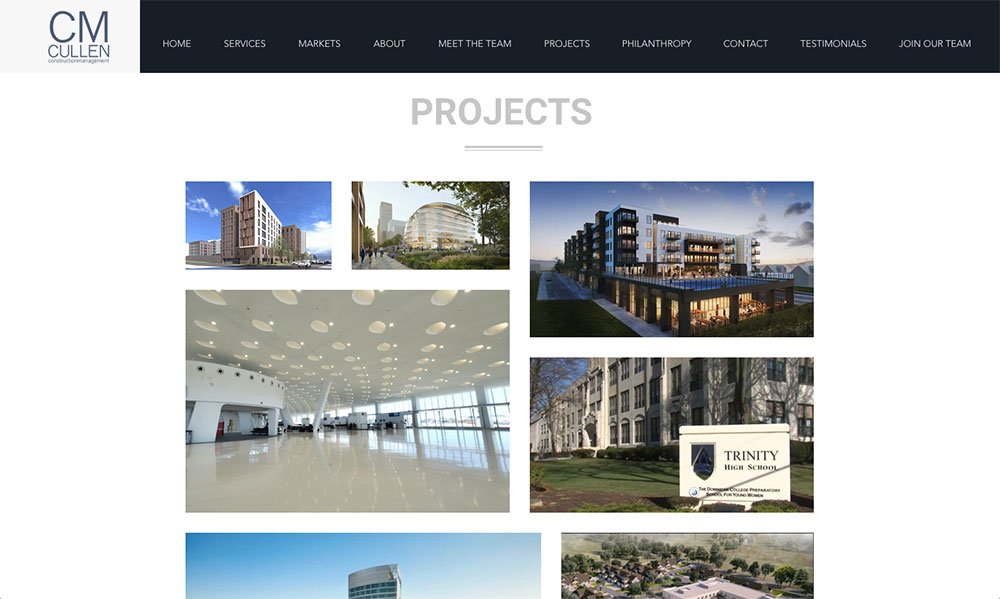

Mini Case Study Gallery
Moriarty designed their gallery to allow for their projects to be sorted by having clickable industries at the top of the page. They also used a 3 column layout with brief descriptions underneath and images. The images can be clicked and opened in a lightbox overlay but contain no additional imagery.
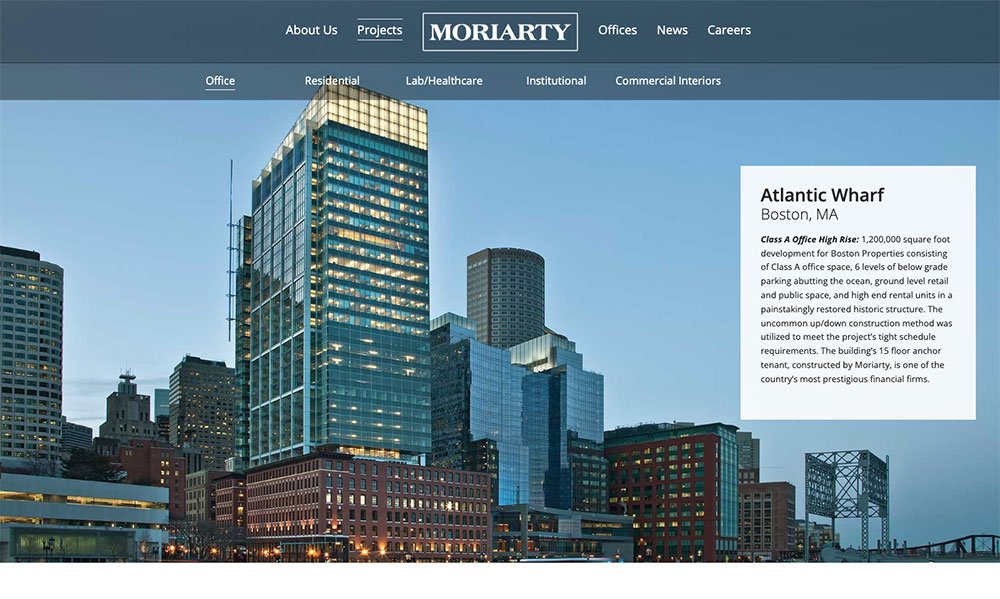

Case Studies Disguised as an Image Gallery
Berglund Construction was an outlier example of an Image Gallery style but had to be included because of the SEO implications. This is the best example of how to do a Gallery style experience.
They used the single-page gallery approach; you can tell because it appears that all the projects live on the same URL even when you click around their other projects, but their web partner structured it so that each project actually lives on its own URL.
The benefit is if you Google "chicago cultural center renovation construction project," Berglund comes up in the results. They're not the first result, but they're in the top 5 results.
They really invested in each project too. Upon clicking, each project expands to a full-blown case study that varies a bit but can provide the following:
- In-depth overviews
- Project highlights
- Quotes from team members
- Project progress photos
- Team members involved
- Videos
- Large gallery viewer of additional high-quality images

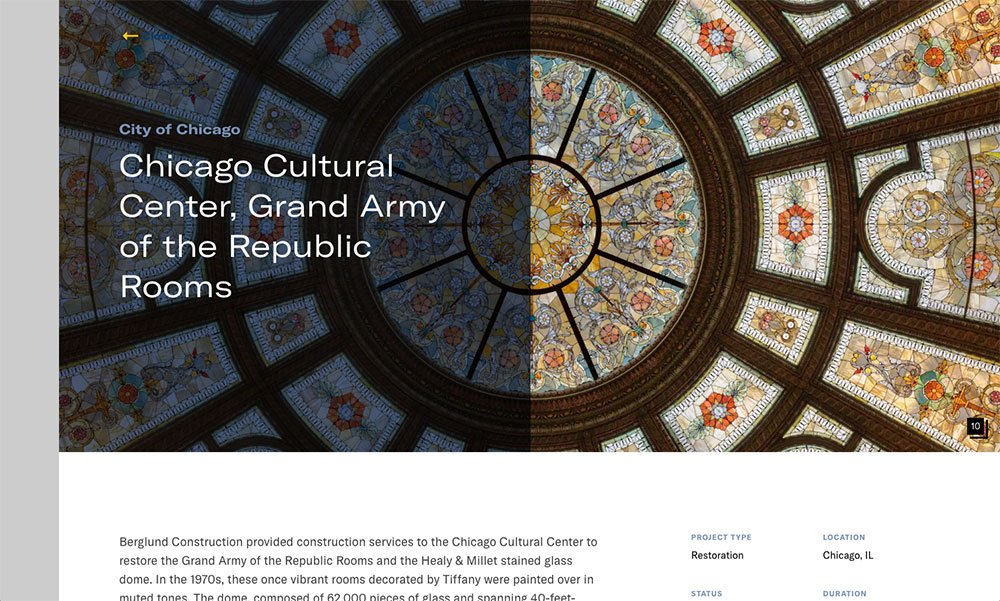
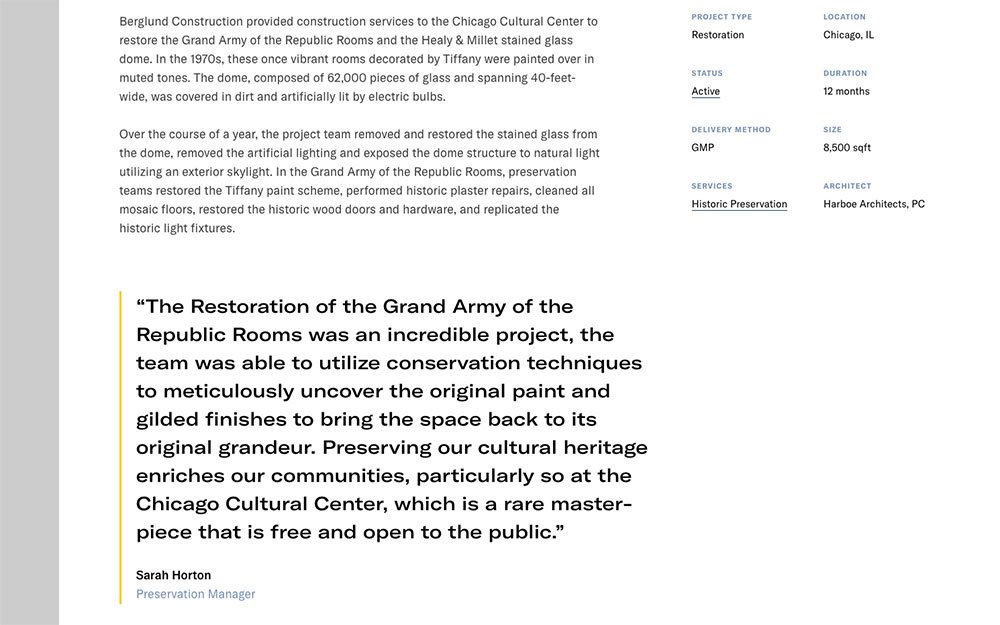
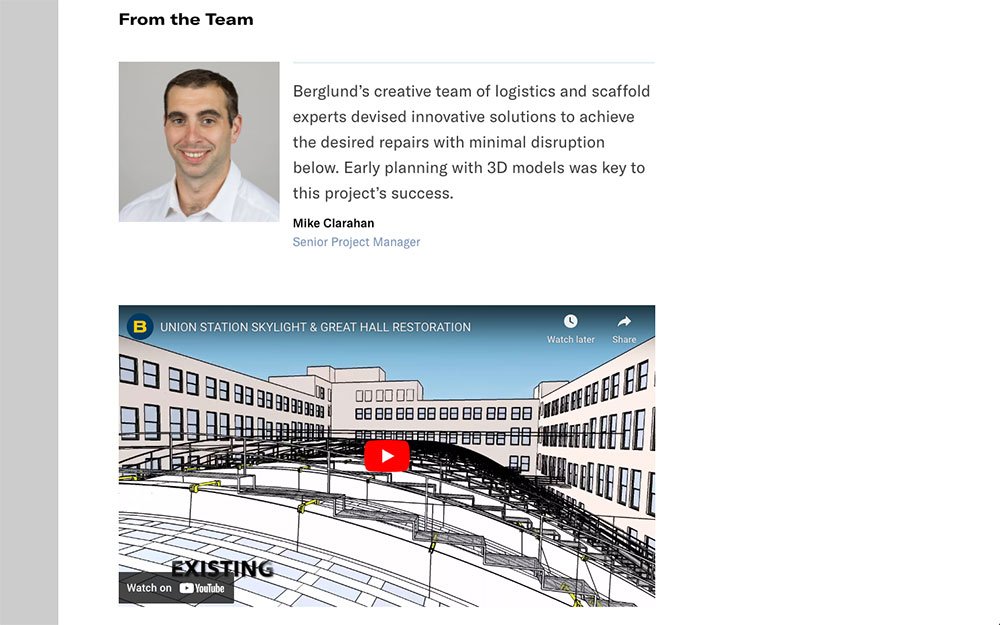
The Brief Case Study
An Efficient Way to Show Off Your Work
The Brief case study style is a great way to show off your work without having to write a lot of text. It's a more visual approach that uses high-quality images and design elements to tell the story of your project.
Of course, there are some limitations to the Brief case study style. They don't provide as much detail as the Benchmark case study format. But that doesn't mean they're not valuable. They can be an efficient and lean way to highlight your work while allowing you to focus on tackling more critical marketing projects.
There are endless variations within the concise layout style, so a few options stood out.
The Brief Case Study with Generous White Space
McHugh Construction had some variance in their case studies, but many followed this concise project format that summarizes the work in a single sentence.
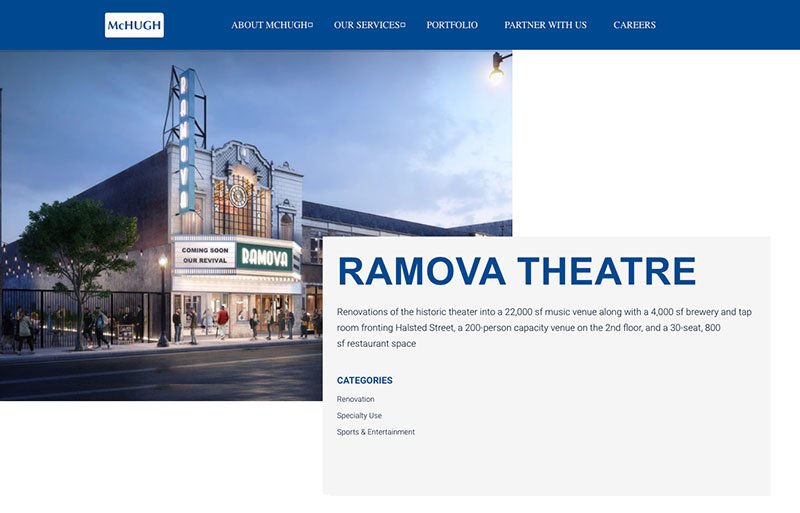
The Brief Case Study with Design Embellishments
Bowa Construction created room for the case study to breathe, and with some excellent design elements, it encourages the user to scroll on.

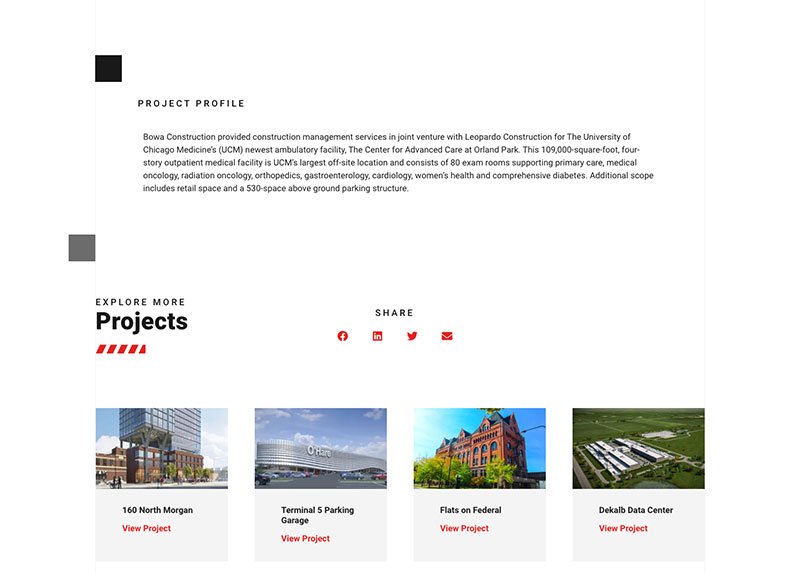
The Brief Case Study with a Stunning Featured Image
Stunning photography is one of the most significant areas of inconsistency. But a few groups had some really dramatic images in a few of their case studies, so it seemed worth calling out.
Graycor, Walsh, and Shawmut had some really dramatic feature photos.


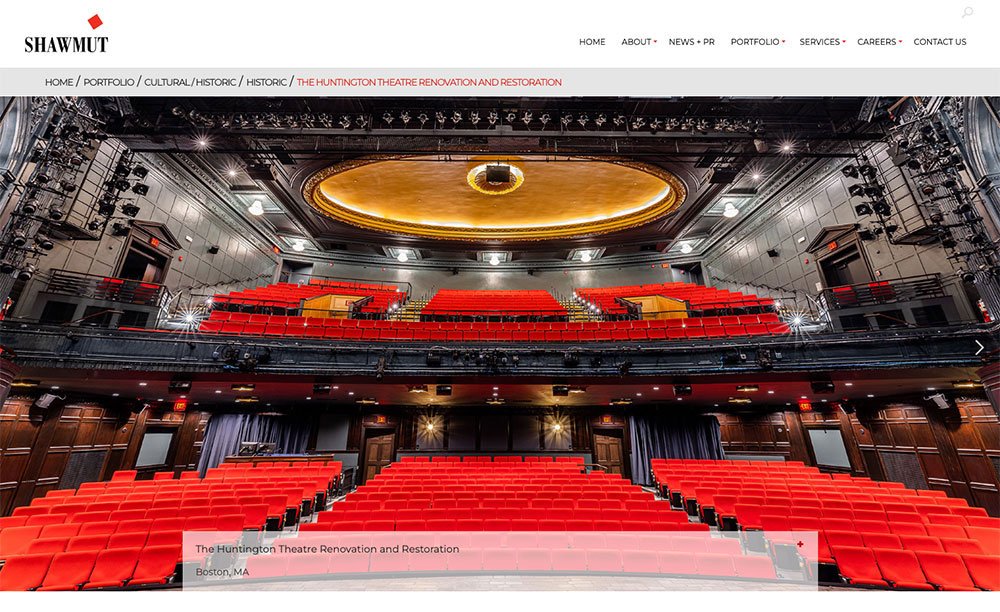
The Brief Case Study with a Gallery of Quality Images
A few groups used the Brief format, but instead of opting for a featured image, they provided a gallery of additional images. They ranged from being viewed in masonry grid format or expanded to be viewed in a clickable gallery.
K.R. Miller definitely did not skimp on the number or quality of their images.
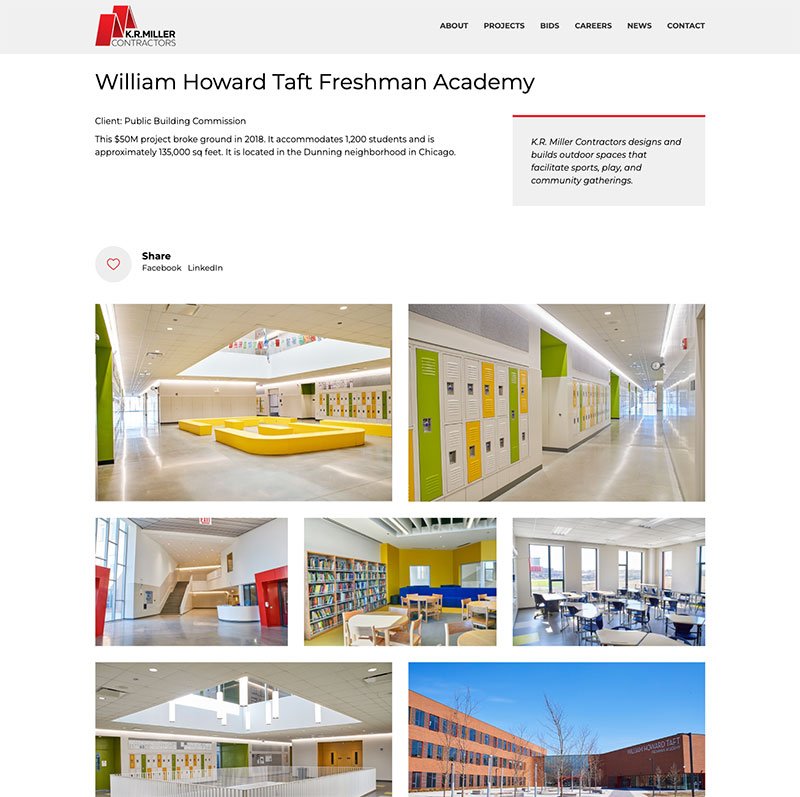

The Benchmark Case Study
The Gold Standard in Case Study Design
This is the gold standard of case study design. It's a comprehensive and informative approach that uses high-quality images, design elements and embraces the storytelling of a project in a visually stunning and engaging way.
This case study's style builds on the previous types in that they tend to do two or more of the following, and this makes them more compelling:
- Use High-quality images: Often, the feature image and supplemental images are large and high-resolution.
- Well-formatted content: The text tends to be well-formatted with subheadings, short paragraphs, and bulleted lists and is easy to scan
- Highly stylized design: It uses typography, color, and whitespace to create a visually stunning and engaging experience for the reader.
- Challenge, Solution, Outcome format: The project overview often follows this format for telling the project story.
- Project stats or highlights: The project contains stats or highlights, such as awards, partners, budgets, or timelines.
- Client testimonials: Some contain social proof demonstrating their commitment to relationships and the value of their work.
- Project videos: Project videos that give a virtual tour of their work and/or feature the client's point of view.
- CTAs: Calls to Action are the last thing many of these case studies include. A call to action clarifies to visitors what they can do next - find a career or discuss a project.
In a subtle way, this style of case study signals to potential candidates and clients that you can deliver the highest-quality work in any medium, whether it be traditional construction or digital construction. While these case studies are in a different stratosphere, there is always room to develop.
The Benchmark Case Study manifested in a few different formats:
- Story Priority
- Visual Priority
- Best of Both Worlds
The Benchmark - Story Priority
This style leaned heavier on the written side of the project story than the imagery. Not good or bad, but the key to making this style work is extra content formatting to make the content easily scanned and read.
Remember, a visitor's average time on a project page is inversely related to the number of projects in your portfolio. If you have under 30 case studies in your portfolio, you might have 60-90 seconds of attention. If you have over 200 case studies, you may only have 30-50 seconds.
Pepper went the extra mile and created a custom icon for awards they won, provided links to additional articles to learn more about the build, and even created a video to tell the story of their epic new Cincinnati office.
Paschen took a more story-focused approach and got a quote from the Project Manager, and provided some additional imagery near the bottom. Lendlease followed this storytelling centric approach as well.
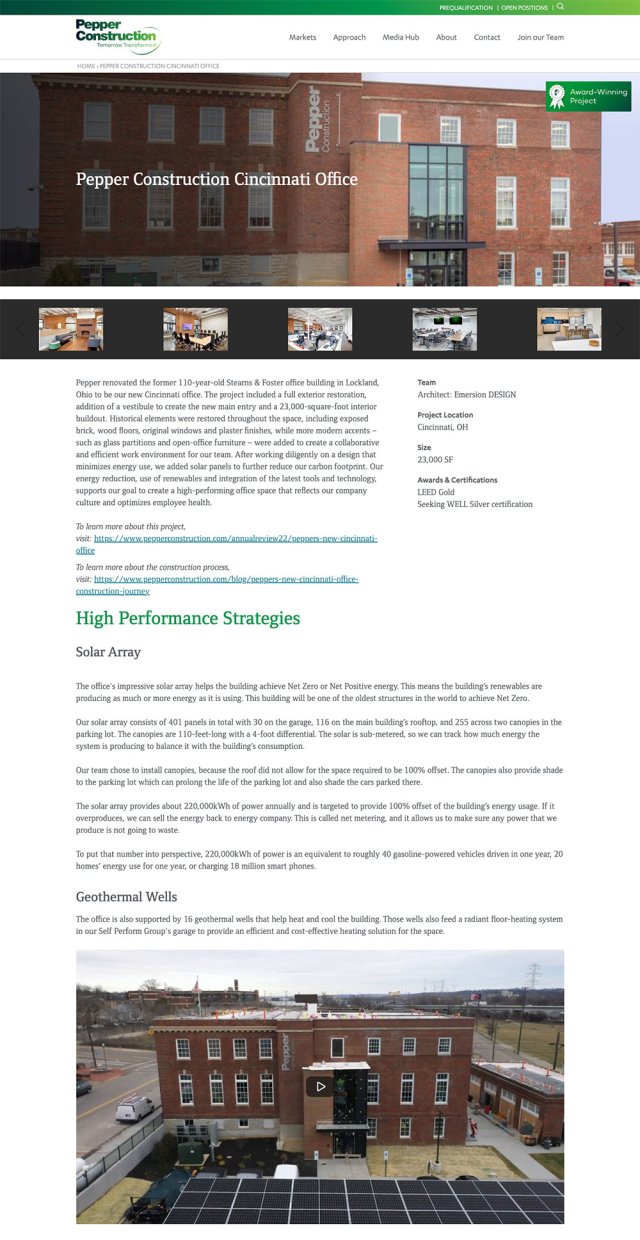
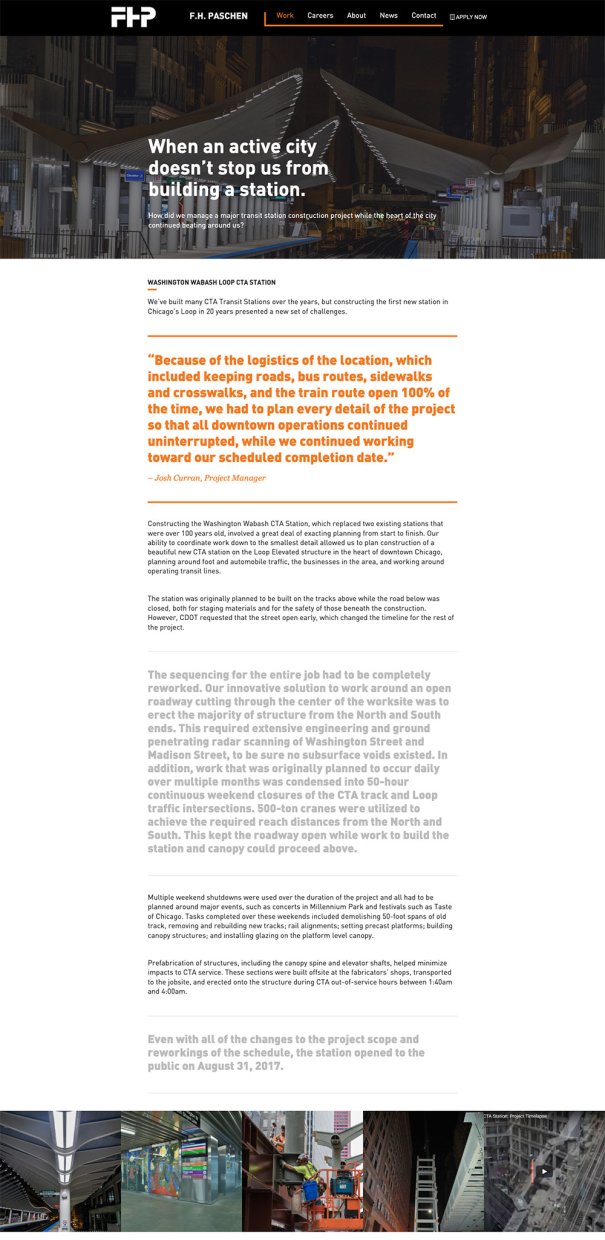

The Benchmark - Visual Priority
This style is a bold and innovative approach that has the potential to engage and excite visitors and get mouths watering very quickly.
However, providing context and answering questions is still important to ensure you're not simply raising more questions.
Power has a stunning project layout and imagery to match their Luxury group projects. They also have some nicely designed project highlights and a slideshow with more high-quality imagery in the header.
GCS||Sigal added a feature video and arranged their imagery in a gradient from colorful completed project photos, gradually blending into black and white progress photos as you scroll down. Suffolk and Arco Murray also embraced a very visually heavy approach.
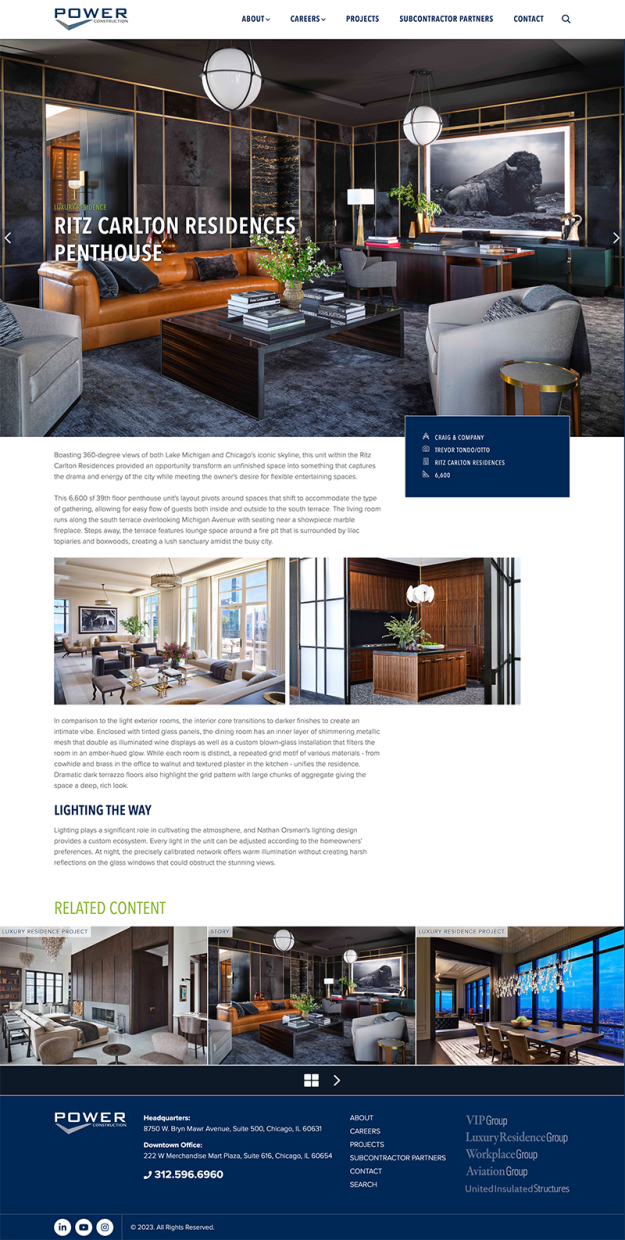
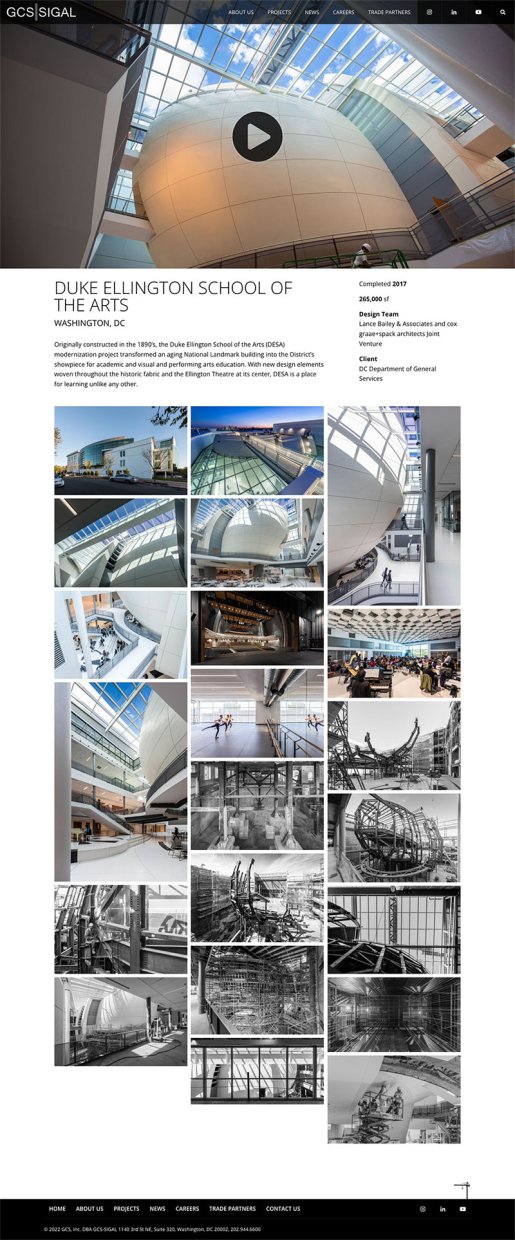
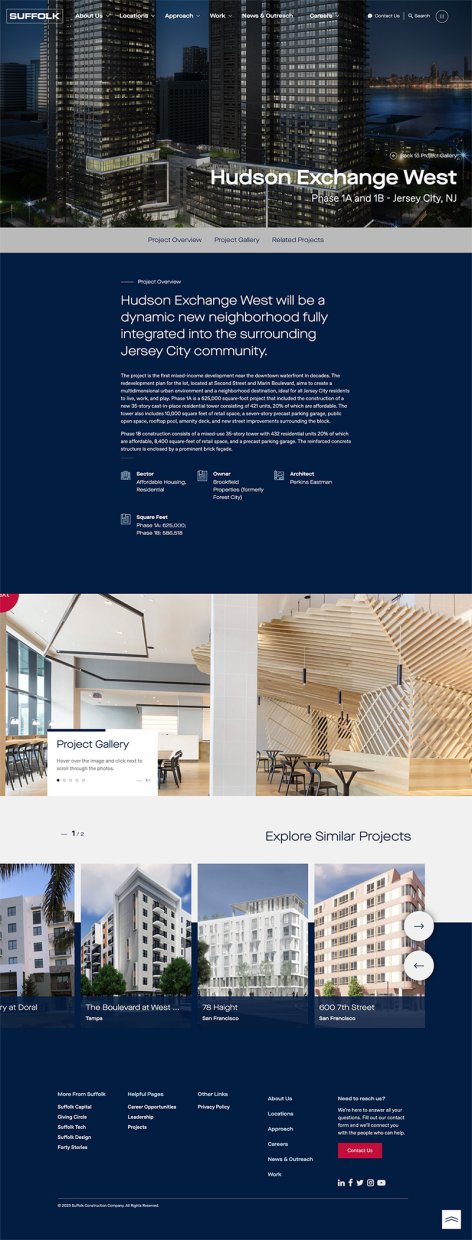
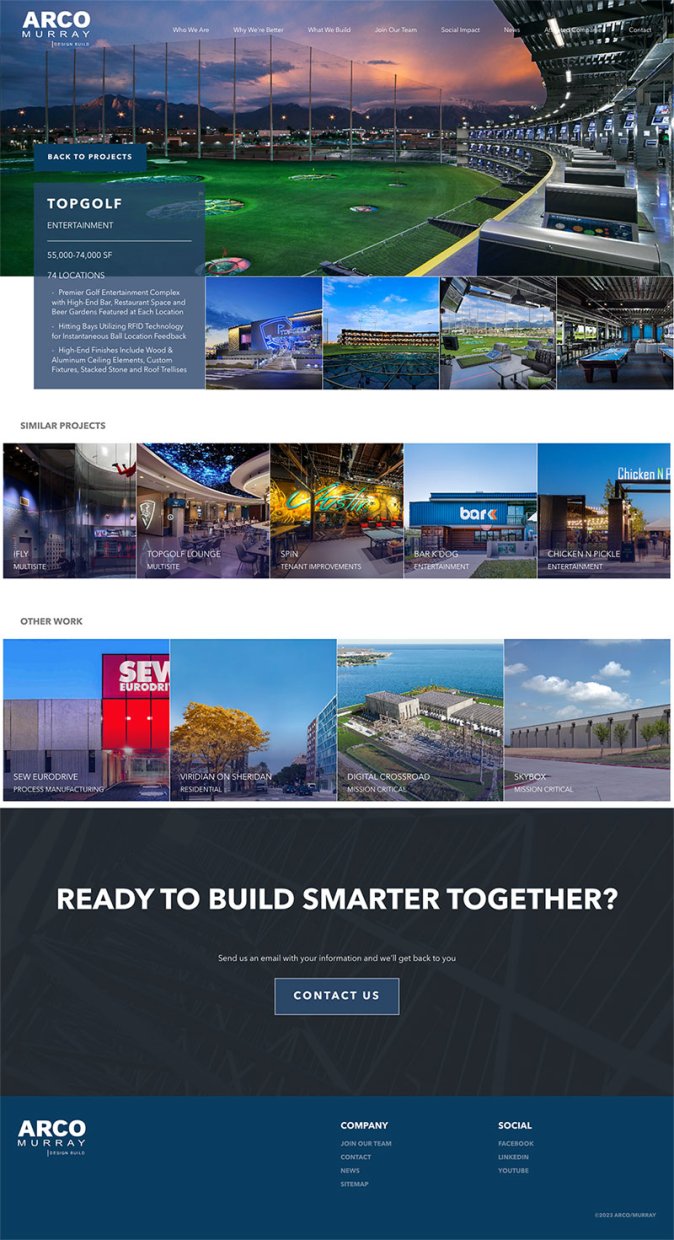
The Benchmark - Best of Both Worlds
This group of sites embodies the love of the story while embracing content design and great visuals.
Very little was missing from this category of case study.
McCarthy went pretty bold and generous from the feature image quality and size, to the project title, the white space, their project stats, their additional imagery, and even their call to "Build Together." Berger, DPR, and PCL all took equally big visual and content swings.
Some areas where this group could still improve would be to limit their paragraphs to no more than 3-4 lines and create subheadings for sections to make the content easier to digest and scan.
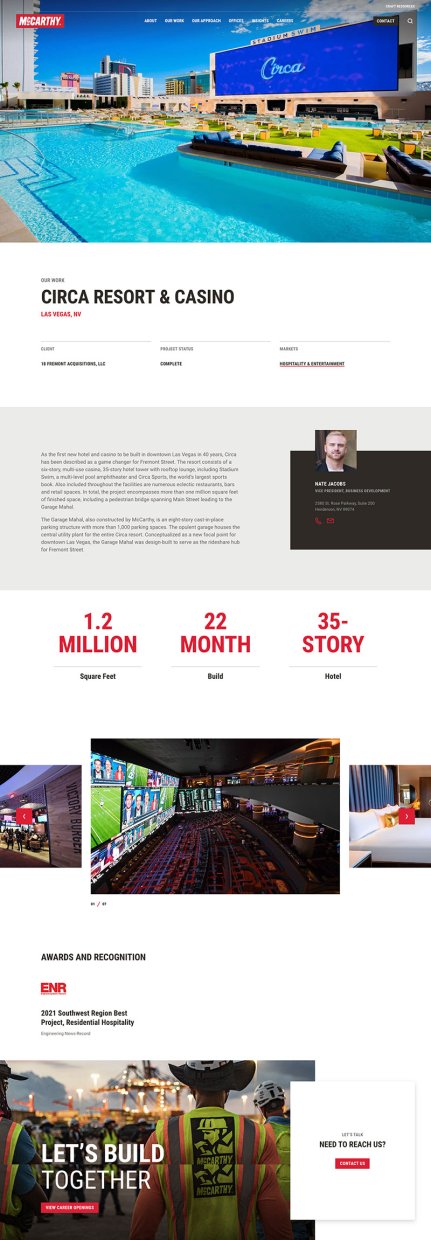


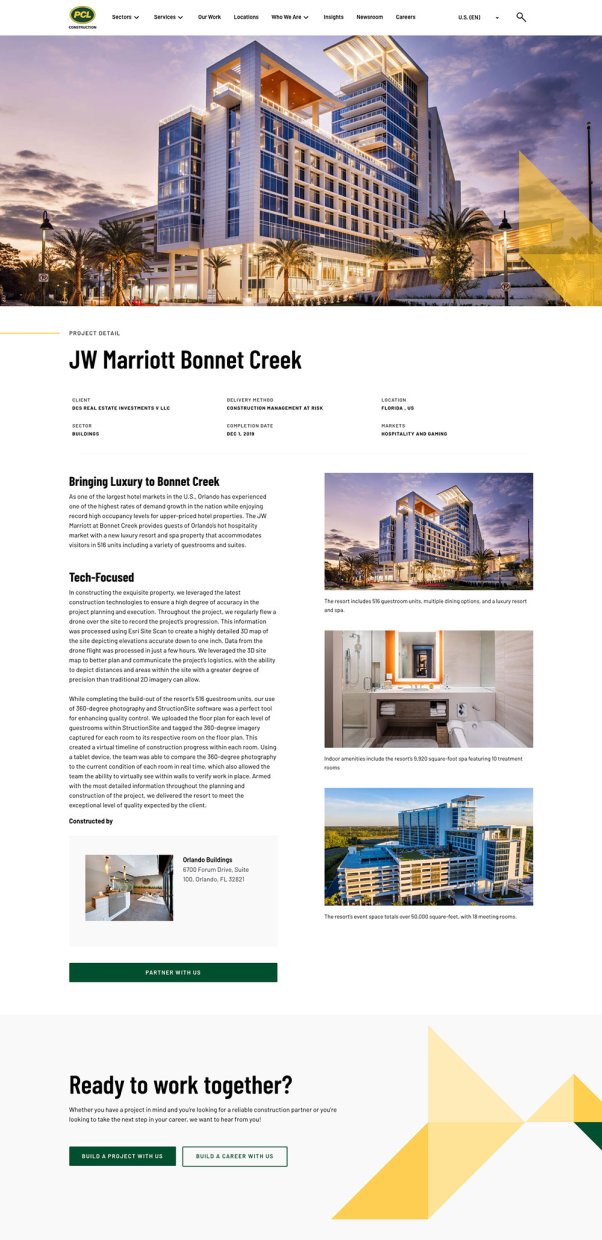
Here are some tips for creating great case studies
- Start with a title that will grab the reader's attention
- Avoid defaulting to the client name for the project name
- Use clear and concise language that is easy to understand
- Include plenty of high-quality images that showcase your work
- Highlight the challenges you faced and the solutions you implemented
- Answer common sales questions
- Interview your team members to highlight your people and to tell the story
- Involve your clients in the story by getting testimonials
If you're not sure how to get testimonials from sensitive clients - see how a US security company got an anonymous testimonial from a Casino client of theirs who had been hacked.
Which case study style is right?
It depends on your goals, level of interest in producing content, and the capacity of your marketing team.
- The Gallery portfolio is a good option if you just need to provide a basic example of your body of work.
- The Brief style can provide a stunning layout without having to become a full-time content wrangler.
- If you want to elevate your brand, then The Benchmark case study approach would be the way to go.
Make sure it's well-written and engaging, no matter which type of case study you choose. Your case studies are a chance to show off your work and your company's expertise, so make sure they do your group justice!
With so many different case study formats, it can be tough to know which one is right for you.
That's why we've done the research and found the 3 most common case study formats used by commercial construction companies.